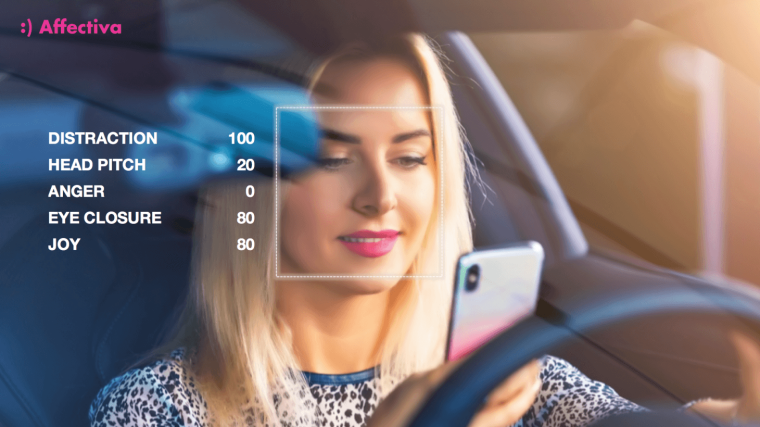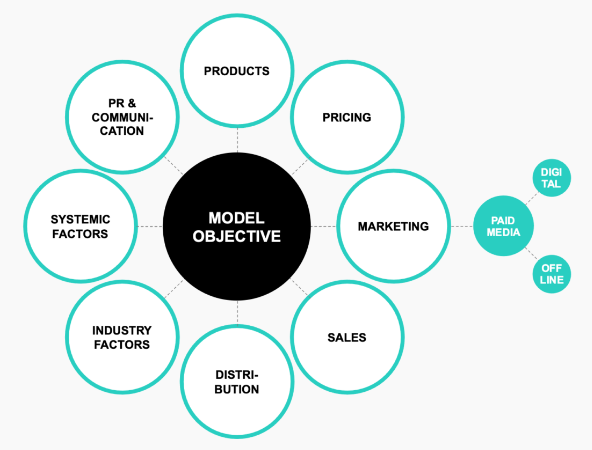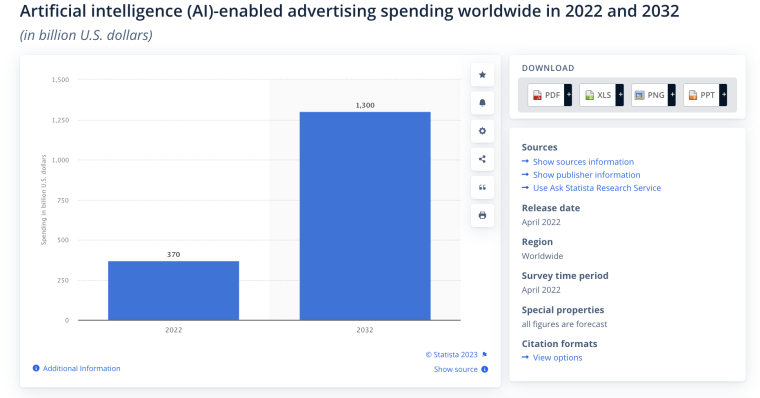At Business2Community, we have found that as digital marketing continues to evolve, the integration of artificial intelligence (AI) in advertising is certain to disrupt the market more than any other technological advancement since the internet.
The technology offers many unique benefits including streamlined hyper-personalization and data-driven strategies, fundamentally altering how brands establish connections with consumers.
With an abundance of data accessible online, making sense of the shift caused by AI in advertising statistics can feel a bit like piecing together a puzzle with half of the pieces missing from scattered reports and various websites.
We’ve curated a variety of information from different sources in this article to help provide a clear understanding of the imminent industry changes that lay ahead.
AI in Advertising Highlights
- The global AI adoption rate stood at 35% in 2022
- The adoption of SaaS large language model APIs by businesses increased by 1,310% in the six months to May 2023
- 75 % of marketing and ads professionals reported using ChatGPT in their work routines, in 2023
- In 2023, 17% of marketing and advertising professionals reported using Microsoft’s AI-powered Bing to help them in their work
- The most used design-related AI tools are Midjourney, DALL-E 2, and Adobe Firefly
Key Takeaways: The Advertising Revolution
- Widespread Adoption: AI’s role in advertising is expanding, enhancing personalization, content creation, and data analysis.
- Technological Integration: Companies are integrating AI to streamline processes, from programmatic ads to predictive analytics in media buying.
- Creative Enhancement: AI is increasingly used for generating creative content and personalizing customer interactions.
- Strategic Partnerships: Notable collaborations, like that between WPP and Nvidia, are setting new standards in AI-driven content creation.
- Future Prospects: The evolving capabilities of AI promise further innovations in advertising strategies and efficiency.
How Is AI Used in Advertising?
AI is already nearly omnipresent in advertising and marketing. 75% of marketing and ads professionals revealed that they used the AI large language model ChatGPT in their work routines, in a 2023 survey across North America, South America, and Europe.
17% opted for Microsoft’s AI-driven Bing, mirroring the same adoption rate as Google’s AI tool, Bard.
AI design tools used by advertisers include Midjourney, DALL-E 2, and Adobe Firefly. The study highlighted that generative AI found its primary roles in advertising and marketing through content drafting, brainstorming, and research tasks:
- 50% of respondents primarily used generative AI for content drafting.
- 48.5% of participants applied generative AI to support brainstorming activities.
- 30% of those surveyed utilized generative AI for research purposes.
- 13% of respondents employed generative AI to enhance personalization efforts.
In a global survey conducted in 2022, 90% of marketing professionals across 35 countries already reported using AI tools to automate customer interactions, up from 88% in 2021. Additionally, 88% of marketers leveraging AI reported that it aided in personalizing the customer journey across various channels.
Chatbot technology helps advertisers communicate with customers, provide insightful responses to queries, and play a creative role in guiding the customer journey.
AI holds the potential to enhance the creative aspects of the marketing and ad creation process. This spans from composing copy for multiple channels to crafting social media visuals, audio content, and posts.
WPP, recognized as the largest ad agency globally, unveiled a strategic alliance with AI hardware giant Nvidia in May 2023. This collaboration aims to revolutionize the content creation paradigm for brands by seamlessly integrating generative AI at a more expansive and customized level.
In a demonstration showcasing the artificial intelligence engine’s capabilities, a 3D car model was ingeniously embedded within an AI-generated video, surrounded by contextually relevant environments.
These landscapes were tailored to target audiences, ranging from business to family-oriented or even location-specific like London or Rio.
In a 2023 Hubspot report on AI use in Marketing, 45% of respondents said they use AI for analyzing and reporting on data. In the same report, 91% of those surveyed said the automation that AI offers saves them time.
AI can also be used in advertising as a means to help segment audiences and better target people with relevant messages. Indeed, in a survey from Salesforce published in 2022, 56% of consumers stated that they want to see personalized ads and for companies to anticipate their needs.
AI in Programmatic Ads
The widespread emergence of AI programmatic advertising began long before ChatGPT’s November 2022 launch. The ad industry recognized AI’s potential early on, propelling the growth of AI-driven ad tech into a thriving sector.
AI’s influence affects every facet of the programmatic advertising process. It’s used in a wide array of tasks from basic data collection and analysis to crafting consumer segments and refining ad targeting.
It also extends to managing finances, optimizing ad budget allocation, and orchestrating programmatic bidding.
Beyond these, it aids in unmasking ad fraud and even utilizes facial recognition for targeted ads, a technique notably employed in digital out-of-home (DOOH) advertising. This innovative approach tailors ads based on the age, gender, and even mood of the passing audience.
What Are Examples of AI Being Used in Advertising?
Advertising companies around the world are already leveraging AI for a multitude of use cases from competitor analysis and ad design, to creative marketing campaigns and ROI optimization. Let’s look at a few prime examples of brilliant uses of AI in advertising.
Kellogg’s Leverages Affectiva AI For Ad Optimization
Cereal giant Kellogg’s (along with other brands like CBS and MARS) uses Affectiva AI to improve ad content and spending. Ads powered by Affectiva ask viewers to turn on their cameras to read their emotions through their facial expressions. This deep learning AI model can detect over 30 different emotions and facial expression metrics, helping companies understand how ads affect people’s feelings. The tool also provides benchmarks for measuring ad content effectiveness based on location, product type, media length, and how often viewers see the ads.

Affectiva AI’s technology has been developed using a large database encompassing more than 65,000 ads and the analysis of over 12 million faces across 90 countries.
| Company | Kellogg’s |
| Location | United States |
| Industry | Food & Beverages |
| Size | 30.000 |
| AI Application | Emotion analysis |
Volkswagen Uses Blackwood Seven’s AI for Predictive Analytics
Volkswagen is at the cutting edge in both its production automation and its use of artificial intelligence in marketing to automate ad-buying decisions.
Faced with subjective suggestions and high costs from its traditional ad agency, Volkswagen’s marketing team opted for a data-driven approach and sought the services of an AI-powered agency, Blackwood Seven. The agency’s complex AI model named Hamilton AI uses large swaths of data in a variety of factors to pick the best media buys for their customers to streamline campaigns, boost sales, reduce ad investment, and more.

The automaker’s AI integration was almost immediately successful and was significantly more cost-effective than using an ad agency. Beyond cost-effectiveness, the implementation translated into an incredible surge in sales of 14-20% from Volkswagen dealerships.
| Company | Volkswagen |
| Location | Germany |
| Industry | Automobile |
| Size | 675,805 employees |
| AI Application | Predictive analytics |
JPMorgan Chase Relies on AI for Copywriting Improvements
Recognizing the AI’s ability to write great copy, JP Morgan Chase entered a collaboration with Persado, a pioneering software startup. Their decision was cemented when AI-generated copy consistently exhibited higher click rates on adverts — often even doubling the figures.
Kristin Lemkau, JPMorgan Chase’s Chief Marketing Officer, noted, “Persado’s technology is incredibly promising. It rewrote copy and headlines that a marketer, using subjective judgment and their experience, likely wouldn’t have. And they worked.”
As Kristin attests, Persado’s impact on Chase’s copywriting was transformative. The alliance yielded a remarkable 450% surge in click-through rates for ads, attributed to Persado’s contributions.
The World Pantry also partnered with Persado and saw a dramatic increase in client engagement.
| Company | JPMorgan Chase |
| Location | United States |
| Industry | Banking |
| Size | 293,723 employees |
| AI Application | Copywriting |
Benefits of AI Being Used in Advertising
Uses of artificial intelligence in advertising encompass the complete process, from brainstorming and ideation to creating designs and copy, and even serving ads and analyzing the data and returns from the campaign. The benefits derived from dramatically increasing efficiency (and sometimes quality) can be astonishing. They include:
AI Accelerates Content Creation
67% of marketers affirm that AI technology plays a pivotal role in expediting the content creation process. In advertising, creativity often suffers due to tight deadlines and multitasking. By harnessing AI, marketers can write swiftly, research efficiently, and expedite publication with ease.
Examples of how advertisers are tapping into AI for diverse ad and content creation include:
- 25% leveraging AI to distill content into key insights.
- 18% employing AI to craft comprehensive outlines.
- 20% utilizing AI for crafting compelling marketing copy.
- 36% harnessing AI to fashion captivating visual content.
Another prominent reason for advertisers to use AI technology is content repurposing, with 13% of advertisers leveraging its capabilities to write. This approach proves invaluable in amplifying content traction.
AI Allows For Personalization At Scale
49% of marketers emphasize AI’s role in delivering personalized ad content. This approach has redefined how brands engage with their audience, transcending generic interactions.
AI is enabling advertisers to surpass conventional demographic targeting. By harnessing AI’s analytical abilities, dynamic customer segments come to life. AI employs data analysis to predict consumer behavior based on historical interactions.
AI Ignites Innovation and Ideation
48% of advertisers regard AI’s ability to ignite innovation and unlock fresh ideas as one of its main benefits. Digital advertising generally requires A/B testing – with AI technology, an unlimited supply of ad copy and design is just a prompt away.
Be it crafting a novel marketing campaign, optimizing for conversions, or exploring design versions, AI-powered chatbots such as ChatGPT, Jasper AI, and HubSpot’s Content Assistant step in as creative collaborators.
Other Benefits of Using AI Being Used Advertising
- Precise ad targeting: Artificial intelligence analyzes vast datasets to identify the most relevant audience segments for ads.
- Data-driven insights: AI processes large volumes of data to provide actionable insights for campaign optimization.
- Predictive analytics: AI forecasts consumer behavior and market trends, aiding in strategic planning.
- Real-time optimization: AI adjusts ad placements and budgets in real-time to maximize campaign performance.
- Automated campaign management: AI technology manages and optimizes campaigns, which means it reduces manual intervention.
- Cross-channel consistency: AI ensures consistent ad messaging across different platforms and channels.
- Content repurposing: AI repurposes existing content and can write for various formats and platforms, maximizing reach.
- Adaptive testing: AI conducts A/B testing and analyzes the results to determine the most effective ad variations.
These benefits underscore AI’s transformative impact on the advertising landscape, optimizing strategies and driving results.
Challenges of Using AI in Advertising
While AI brings an abundance of benefits for advertising, it also comes with quite a few challenges.
A Russian ‘deepfake’ ad featuring celebrity actor Bruce Willis that surfaced in 2022 was an initial sign pointing to how things can quickly turn strange and potentially problematic with the involvement of AI.
This particular ad had Bruce Willis’ consent to make the ad but other companies following in their wake don’t always do this. A slew of fake ads imitating popular celebrities and influencers recently appeared on TikTok and other social media apps without the consent of those who were ‘deepfaked.’ One of these ads faked popular podcaster Joe Rogan’s voice to endorse a supplement and went viral for how realistic it was.
A 2023 study titled “Ethical and Legal Challenges of AI in Marketing: An Exploration of Solutions” sheds light on the multifaceted ethical and legal quandaries arising from the integration of AI in marketing.
The study reveals that AI’s infusion into the marketing landscape triggers a spectrum of ethical concerns, including issues such as:
- Discrimination
- Bias
- Manipulation
- Job displacement
- reduced social interactions
- Cybersecurity vulnerabilities
- Unintended consequences
- Environmental repercussions
- Privacy breaches
- Transparency hurdles
The study also points out that the realm of advertising and marketing driven by AI gives rise to an array of legal considerations, spanning consumer security, responsibility, liability, brand protection, adherence to competition regulations, negotiation of contractual agreements, data privacy, consumer safeguarding, and protection of intellectual property rights.
Beyond the ethical and legal considerations that crop up when you use AI, the technology has a myriad of other issues surrounding its accuracy, including a phenomenon called AI hallucination where it confidently gets facts completely wrong.
The Future of AI Uses in Advertising
The utilization of artificial intelligence to enhance advertising efforts was predicted to lead to a significant expenditure on ads of around $370 billion by the year 2022.
Looking ahead, the projections present an even more expansive perspective, suggesting that this integration of artificial intelligence technology in advertising could potentially drive ad spending to a substantial $1.3 trillion within the subsequent decade.
These projections highlight the increasing acknowledgment of AI’s potential influence on advertising practices and its potential to reshape advertising strategies on a global scale.
Closing Thoughts: AI in Advertising
Artificial Intelligence is revolutionizing the advertising industry by enabling more personalized, efficient, and innovative campaigns.
With tools like ChatGPT and DALL-E 2, advertisers can automate and optimize ad content creation and targeting, leading to significant improvements in engagement and ROI.
However, as AI continues to evolve, companies must navigate ethical considerations and potential regulatory challenges to fully leverage its benefits.
